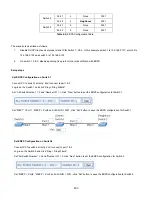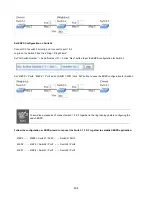
417
the same credentials for authentication from any point within the network.
IGMP
IGMP is an acronym for
I
nternet
G
roup
M
anagement
P
rotocol. It is a communications protocol used to manage the
membership of Internet Protocol multicast groups. IGMP is used by IP hosts and adjacent multicast routers to establish
multicast group memberships. It is an integral part of the IP multicast specification, like ICMP for unicast connections.
IGMP can be used for online video and gaming, and allows more efficient use of resources when supporting these uses.
IGMP Querier
A router sends IGMP Query messages onto a particular link. This router is called the Querier.
IMAP
IMAP is an acronym for
I
nternet
M
essage
A
ccess
P
rotocol. It is a protocol for email clients to retrieve email messages
from a mail server.
IMAP is the protocol that IMAP clients use to communicate with the servers, and SMTP is the protocol used to transport
mail to an IMAP server.
The current version of the Internet Message Access Protocol is IMAP4. It is similar to Post Office Protocol version 3
(POP3), but offers additional and more complex features. For example, the IMAP4 protocol leaves your email messages
on the server rather than downloading them to your computer. If you wish to remove your messages from the server, you
must use your mail client to generate local folders, copy messages to your local hard drive, and then delete and expunge
the messages from the server.
IP
IP is an acronym for
I
nternet
P
rotocol. It is a protocol used for communicating data across an internet network.
IP is a "best effort" system, which means that no packet of information sent over is assured to reach its destination in the
same condition it was sent. Each device connected to a Local Area Network (LAN) or Wide Area Network (WAN) is given
an Internet Protocol address, and this IP address is used to identify the device uniquely among all other devices
connected to the extended network.
The current version of the Internet protocol is IPv4, which has 32-bits Internet Protocol addresses allowing for in excess
of four billion unique addresses. This number is reduced drastically by the practice of webmasters taking addresses in
large blocks, the bulk of which remain unused. There is a rather substantial movement to adopt a new version of the
Internet Protocol, IPv6, which would have 128-bits Internet Protocol addresses. This number can be represented roughly
by a three with thirty-nine zeroes after it. However, IPv4 is still the protocol of choice for most of the Internet.
IPMC
Summary of Contents for NS4750-24S-4T-4X
Page 1: ...NS4750 24S 4T 4X User Manual P N 1702826 REV 00 01 ISS 14JUL14 ...
Page 56: ...56 Figure 4 2 7 Privilege Levels Configuration Page Screenshot ...
Page 110: ...110 Figure 4 4 6 Mirror Configuration Page Screenshot ...
Page 117: ...117 Figure 4 5 4 LACP Port Configuration Page Screenshot ...
Page 174: ...174 Figure 4 7 10 MST1 MSTI Port Configuration Page Screenshot ...
Page 180: ...180 Figure 4 8 2 Multicast Flooding ...
Page 249: ...249 Figure 4 9 18 Voice VLAN Configuration Page Screenshot ...
Page 271: ...271 Counter Counts the number of frames that match this ACE ...
Page 281: ...281 Figure 4 11 4 Network Access Server Configuration Page Screenshot ...
Page 315: ...315 ...
Page 328: ...328 ...
Page 335: ...335 ...
Page 346: ...346 Figure 4 14 1 LLDP Configuration Page Screenshot ...
Page 350: ...350 Figure 4 14 2 LLDP MED Configuration Page Screenshot ...
Page 372: ...372 Figure 4 16 1 Loop Protection Configuration Page Screenshot ...













































